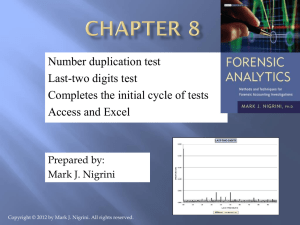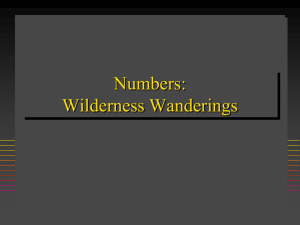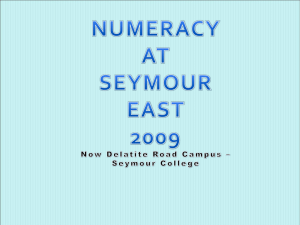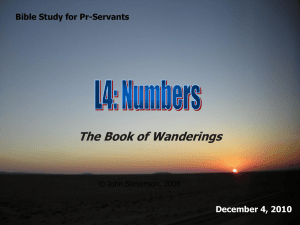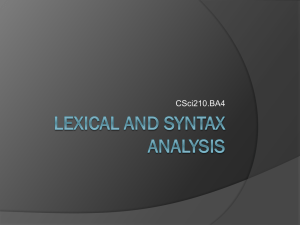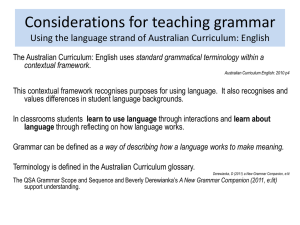Parametric Shape Analysis via 3
advertisement
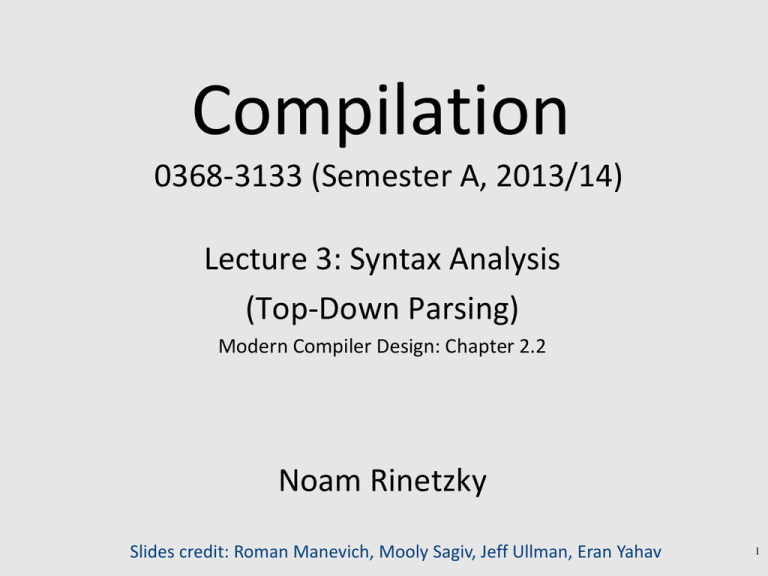
Compilation
0368-3133 (Semester A, 2013/14)
Lecture 3: Syntax Analysis
(Top-Down Parsing)
Modern Compiler Design: Chapter 2.2
Noam Rinetzky
Slides credit: Roman Manevich, Mooly Sagiv, Jeff Ullman, Eran Yahav
1
Admin
• Slides: http://www.cs.tau.ac.il/~maon/…
– All info: Moodle
• Next week: Dan David 001
– Vote …
• Mobiles ...
2
What is a Compiler?
“A compiler is a computer program that
transforms source code written in a
programming language (source language)
into another language (target language).
The most common reason for wanting to
transform source code is to create an
executable program.”
--Wikipedia
3
Conceptual Structure of a Compiler
Compiler
txt
Source
exe
Frontend
Semantic
Backend
Representation
text
Executable
code
Lexical
Analysis
Syntax
Analysis
Parsing
Semantic
Analysis
Intermediate
Representation
(IR)
Code
Generation
4
Conceptual Structure of a Compiler
Compiler
txt
Source
exe
Frontend
Semantic
Backend
Representation
text
Executable
code
Lexical
Analysis
Syntax
Analysis
Semantic
Analysis
Parsing
words
sentences
Intermediate
Representation
(IR)
Code
Generation
5
Lexical Analysis Refresher
• Example: Lang. of fully parenthesized exprs
Expr Num | LP Expr Op Expr RP
Num Dig | Dig Num
Dig ‘0’|‘1’|‘2’|‘3’|‘4’|‘5’|‘6’|‘7’|‘8’|‘9’
LP ‘(’
RP ‘)’
Op ‘+’ | ‘*’
(
(
23
+
7
)
*
19
)
6
What does Lexical Analysis do?
• Language: fully parenthesized expressions
Context free
language
Regular
languages
Expr Num | LP Expr Op Expr RP
Num Dig | Dig Num
Dig ‘0’|‘1’|‘2’|‘3’|‘4’|‘5’|‘6’|‘7’|‘8’|‘9’
LP ‘(’
RP ‘)’
Op ‘+’ | ‘*’
(
(
23
+
7
)
*
19
)
7
What does Lexical Analysis do?
• Language: fully parenthesized expressions
Context free
language
Regular
languages
Expr Num | LP Expr Op Expr RP
Num Dig | Dig Num
Dig ‘0’|‘1’|‘2’|‘3’|‘4’|‘5’|‘6’|‘7’|‘8’|‘9’
LP ‘(’
RP ‘)’
Op ‘+’ | ‘*’
Token
Token
…
Value
(
(
23
+
7
)
*
19
)
Kind
LP
LP
Num
Op
Num
RP
Op
Num
RP
8
Scanners: Spec. & Impl.
if
[a-z][a-z0-9]*
[0-9]+
[0-9]”.”[0-9]*|[0-9]*”.”[0-9]+
(\-\-[a-z]*\n)|(“ “|\n|\t)
.
{
{
{
{
{
{
return IF; }
return ID; }
return NUM; }
return REAL; }
; }
error(); }
Scanner usage
of DFSM goes
beyond language
recognition
9
Frontend: Scanning & Parsing
program text
((23 + 7) * x)
Lexical
Analyzer
token stream
(
(
23
+
7
)
*
x
)
LP
LP
Num
OP
Num
RP
OP
Id
RP
Grammar:
E ... | Id
Id ‘a’ | ... | ‘z’
Parser
syntax
error
valid
Op(*)
Op(+)
Abstract Syntax Tree
Id(b)
Num(23) Num(7)
10
From scanning to parsing
program text
((23 + 7) * x)
Lexical
Analyzer
token stream
(
(
23
+
7
)
*
x
)
LP
LP
Num
OP
Num
RP
OP
Id
RP
Grammar:
E ... | Id
Id ‘a’ | ... | ‘z’
Parser
syntax
error
valid
Op(*)
Op(+)
Abstract Syntax Tree
Id(b)
Num(23) Num(7)
11
Parsing
• Goals
– Is a sequence of tokens a valid program in the language?
– Construct a structured representation of the input text
– Error detection and reporting
• Challenges
–
–
–
–
How do you describe the programming language?
How do you check validity of an input?
How do you construct the structured representation?
Where do you report an error?
12
Lecture Outline
Role & place of syntax analysis
• Context free languages
– Grammars
– Push down automata (PDA)
•
•
•
•
Predictive parsing
Error handling
Semantics actions
Earley parser
13
Context free languages
• Example: { 0n1n | n > 0 }
• Context Free Grammars (CFG)
~
• Push Down Automata (PDA)
– Non Deterministic Pushdown Automata
14
Context free grammars (CFG)
G = (V,T,P,S)
• V – non terminals (syntactic variables)
• T – terminals (tokens)
• P – derivation rules
– Each rule of the form V
(T
V)*
• S – start symbol
15
What can CFGs do?
• Recognize CFLs
•S
•T
0T1
0T1 | ℇ
16
Pushdown Automata
• Nondeterministic PDA is an automaton
that defines a CFL language
– Nondeterministic PDAs define all CFLs
• Equivalent to the CFG in language-defining power
• The deterministic version models parsers.
– Most programming languages have
deterministic PDAs
– Efficient implementation
17
Intuition: PDA
• An ε-NFA with the additional power to
manipulate a stack
Top
X
Y
IF
$
stack
control (ε-NFA)
18
Intuition: PDA
• Think of an ε-NFA with the additional
power that it can manipulate a stack
• Its moves are determined by:
– The current state (of its “ε-NFA”)
– The current input symbol (or ε)
– The current symbol on top of its stack
19
Intuition: PDA
Current
input
Top
if (oops) then stat:= blah else abort
X
Y
IF
$
stack
control (ε-NFA)
20
Intuition: PDA – (2)
• Moves:
– Change state
– Replace the top symbol by 0…n symbols
• 0 symbols = “pop” (“reduce”)
• 0 < symbols = sequence of “pushes” (“shift”)
• Nondeterministic choice of next move
21
PDA Formalism
• PDA = (A, Σ, Γ, q0, $, F):
–
–
–
–
–
–
–
A finite set of states (Q, typically).
An input alphabet (Σ, typically).
A stack alphabet (Γ, typically).
A transition function (δ, typically).
A start state (q0, in Q, typically).
A start symbol ($, in Γ, typically).
A set of final states (F ⊆ Q, typically).
22
The Transition Function
• δ(q, a, X) = { (p1, σ1), … ,(pn, σn)}
– Input: triplet
• A state q ∊ Q
• An input symbol a ∊ Σ or ε
• A stack symbol X ∊ Γ
– Output: set of 0 … k actions of the form (p, σ)
• A state q ∊ Q
• σ a sequence X1⋯Xn ∊ Γ* of stack symbols
23
Actions of the PDA
• Say (p, σ) ∊ δ(q, a, X)
– If the PDA is in state q and X is the top symbol
and a is at the front of the input
– Then it can
• Change the state to p.
• Remove a from the front of the input
– (but a may be ε).
• Replace X on the top of the stack by σ.
24
Example: Deterministic PDA
• Design a PDA to accept {0n1n | n > 1}.
• The states:
– q = start state. We are in state q if we have
seen only 0’s so far.
– p = we’ve seen at least one 1 and may now
proceed only if the inputs are 1’s.
– f = final state; accept.
25
Example: Stack Symbols
• $ = start symbol. Also marks the bottom of
the stack, so we know when we have
counted the same number of 1’s as 0’s.
• X = “counter”, used to count the number of
0’s seen on the input.
26
Example: Transitions
• δ(q, 0, $) = {(q, X$)}.
• δ(q, 0, X) = {(q, XX)}.
– These two rules cause one X to be pushed onto the
stack for each 0 read from the input.
• δ(q, 1, X) = {(p, ε)}.
– When we see a 1, go to state p and pop one X.
• δ(p, 1, X) = {(p, ε)}.
– Pop one X per 1.
• δ(p, ε, $) = {(f, $)}.
– Accept at bottom.
27
Actions of the Example PDA
000111
q
$
28
Actions of the Example PDA
000111
q
X
$
29
Actions of the Example PDA
000111
q
X
X
$
30
Actions of the Example PDA
000111
q
X
X
X
$
31
Actions of the Example PDA
000111
p
X
X
$
32
Actions of the Example PDA
000111
p
X
$
33
Actions of the Example PDA
000111
p
$
34
Actions of the Example PDA
000111
f
$
35
Example: Non Deterministic PDA
• A PDA that accepts palindromes
– L {pp’ ∊ Σ* | p’=reverse(p)}
36
Instantaneous Descriptions
• We can formalize the pictures just seen
with an instantaneous description (ID).
• A ID is a triple (q, w, ), where:
– q is the current state.
– w is the remaining input.
– is the stack contents, top at the left.
• Define a transition relation between IDs
37
Context free grammars
G = (V,T,P,S)
• V – non terminals (syntactic variables)
• T – terminals (tokens)
• P – derivation rules
– Each rule of the form V
(T
V)*
• S – start symbol
38
Example grammar
SS;S
S id := E
E id
E num
EE+E
S shorthand
for Statement
E shorthand
for Expression
39
CFG terminology
SS;S
S id := E
E id
E num
EE+E
Symbols:
Terminals (tokens): ; := ( ) id num print
Non-terminals: S E L
Start non-terminal: S
Convention: the non-terminal appearing
in the first derivation rule
Grammar productions (rules)
Nμ
40
CFG terminology
• Derivation - a sequence of replacements of
non-terminals using the derivation rules
• Language - the set of strings of terminals
derivable from the start symbol
• Sentential form - the result of a partial
derivation in which there may be nonterminals
41
Derivations
• Show that a sentence ω is in a grammar G
– Start with the start symbol
– Repeatedly replace one of the non-terminals
by a right-hand side of a production
– Stop when the sentence contains only
terminals
• Given a sentence αNβ and rule Nµ
αNβ => αµβ
• ω is in L(G) if S =>* ω
42
sentence
x := z;
y := x + z
S
S ; S
id := E ; S
id := E ; id
id := id ;id
id := id ;id
id := id ;id
id := id ;id
Derivation
grammar
S
S
E
:=
:=
:=
:=
:=
S;S
id := E | …
id | E + E | E * E |…
E
E
E + E
E + id
id + id
S
S
S
E
E
E
E
S;S
id := E
id := e
id
E + E
id
id
<id,”x”><ASS><id,”z”><SEMI> <id,”y”><ASS><id,”x”><PLUS><id,”z”>
43
Parse trees: Traces of
Derivations
• Tree nodes are symbols, children ordered left-to-right
• Each internal node is non-terminal and its children
correspond to one of its productions N
N µ1 … µk
µ1
… µk
• Root is start non-terminal
• Leaves are tokens
• Yield of parse tree: left-to-right walk over leaves
44
Parse Tree
S
S
S ; S
id := E ; S
S
id := id ; S
id := id ;id := E
S
E
id
:=
E
id := id ;id := E + E
id := id ;id := E + id
E
id := id ;id := id + id
x:= z ; y := x
E
+ z
id
:=
id
;
id
+
id
45
Language of a CFG
• A sentence ω is in L(G) (valid program) if
– There exists a corresponding derivation
– There exists a corresponding parse tree
46
Questions
• How did we know which rule to apply on
every step?
• Would we always get the same result?
• Does it matter?
47
Ambiguity
S
S
E
x := y+z*w
S ; S
id := E | …
id | E + E | E * E | …
S
id
S
:=
E
E
+
E
id
E
*
id
id
:=
E
E
E
E
id
id
+
*
E
E
id
id
48
Leftmost/rightmost Derivation
• Leftmost derivation
– always expand leftmost non-terminal
• Rightmost derivation
– Always expand rightmost non-terminal
• Allows us to describe derivation by listing the
sequence of rules
– always know what a rule is applied to
49
Leftmost Derivation
x := z;
y := x + z
id :=
id :=
id :=
id :=
id :=
id :=
x :=
S
S ; S
E ; S
id ; S
id ; id
id ; id
id ; id
id ; id
z ; y
S
S;S
S
id := E
E
id | E + E | E * E | ( E )
:= E
:= E + E
:= id + E
:= id + id
:= x + z
S
S
E
S
E
E
E
S;S
id := E
id
id := E
E + E
id
id
50
Rightmost Derivation
<id,”x”> ASS <id,”z”> ;
<id,”y”> ASS <id,”x”> PLUS
<id,”z”>
S
S
S
S
S
id := E
id := id
S
S
E
S;S
id := E | …
id | E + E | E * E | …
S
; S
; id := E
; id := E + E
; id := E + id
; id := id + id
; id := id + id
; id := id + id
<id,”x”> ASS <id,”z”> ; <id,”y”> ASS
S
S
E
E
E
S
E
<id,”x”> PLUS <id,”z”>
S;S
id := E
E + E
id
id
id := E
id
51
Sometimes there are two parse trees
Arithmetic
expressions:
E id
E num
EE+E
EE*E
E(E)
1+2+3
“1 + (2 + 3)”
“(1 + 2) + 3”
E
E
E
E
E
E
E
num(1) + num(2) + num(3)
Leftmost derivation
E
E+E
num + E
num + E + E
num + num + E
num + num + num
E
num(1) +
E
E
num(2) + num(3)
Rightmost derivation
E
E+E
E + num
E + E + num
E + num + num
num + num + num
52
Is ambiguity a problem?
Arithmetic
expressions:
E id
E num
EE+E
EE*E
E(E)
1+2+3
“1 + (2 + 3)”
“(1 + 2) + 3”
E
E
E
E
E
E
E
num(1) + num(2) + num(3)
Leftmost derivation
E
E+E
num + E
num + E + E
num + num + E
num + num + num
E
=6
num(1) +
E
E
num(2) + num(3)
Rightmost derivation
E
E+E
E + num
E + E + num
E + num + num
num + num + num
=6
53
Problematic ambiguity example
Arithmetic
expressions:
E id
E num
EE+E
EE*E
E(E)
1+2*3
“1 + (2 * 3)”
E
E
“(1 + 2) * 3”
This is what we
usually want: * has
precedence over +
E
E
E
E
E
num(1) + num(2) * num(3)
Leftmost derivation
E
E+E
num + E
num + E * E
num + num * E
num + num * num
E
=7
num(1) +
E
E
num(2) * num(3)
Rightmost derivation
E
E*E
E * num
E + E * num
E + num * num
num + num * num
=9
54
Ambiguous grammars
• A grammar is ambiguous if there exists a sentence
for which there are
– Two different leftmost derivations
– Two different rightmost derivations
– Two different parse trees
• Property of grammars, not languages
• Some languages are inherently ambiguous – no
unambiguous grammars exist
• No algorithm to detect whether arbitrary grammar
is ambiguous
55
Drawbacks of ambiguous grammars
• Ambiguous semantics
– 1 + 2 * 3 = 7 or 9
• Parsing complexity
• May affect other phases
• Solutions
– Transform grammar into non-ambiguous
– Handle as part of parsing method
• Using special form of “precedence”
56
Transforming ambiguous grammars
to non-ambiguous by layering
Ambiguous grammar
EE+E
EE*E
E id
E num
E(E)
Unambiguous grammar
EE+T
Layer 1
ET
TT*F
Layer 2
TF
F id
Layer 3
F num
F(E)
Each layer takes
care of one way of
composing substrings to form a
string:
1: by +
2: by *
3: atoms
Let’s derive 1 + 2 * 3
57
Transformed grammar: * precedes +
Ambiguous
grammar
EE+E
EE*E
E id
E num
E(E)
Unambiguous grammar
EE+T
ET
TT*F
TF
Parse tree
F id
F num
E
F(E)
Derivation
E
=> E + T
=> T + T
=> F + T
=> 1 + T
=> 1 + T * F
=> 1 + F * F
=> 1 + 2 * F
=> 1 + 2 * 3
E
T
T
T
F
F
1
+
2
F
*
3
58
Transformed grammar: + precedes *
Ambiguous
grammar
EE+E
EE*E
E id
E num
E(E)
Unambiguous grammar
EE*T
ET
TT+F
TF
F id
F num
F(E)
Derivation
E
=> E * T
=> T * T
=> T + F * T
=> F + F * T
=> 1 + F * T
=> 1 + 2 * T
=> 1 + 2 * F
=> 1 + 2 * 3
Parse tree
E
E
T
T
T
F
1
F
+
2
F
*
3
59
Another example for layering
Ambiguous
grammar
Pε
|PP
|(P)
P
P
P
(
(
P
P
P
P
P
P
P
P
ε
)
(
ε
)
)
(
(
ε
)
(
ε
)
)
ε
60
Another example for layering
Unambiguous grammar
SPS
|ε
P(S)
Ambiguous grammar
Pε
|PP
|(P)
Takes care of
“concatenation”
Takes care of nesting
s
P
s
s
(
(
P
P
S
S
ε
)
(
ε
s
s
)
ε
)
ε
61
“dangling-else” example
Ambiguous grammar
S if E then S
S | if E then S else S
| other
p. 174
Unambiguous grammar
This is what we usually
want: match else to closest
unmatched then
?
if E1 then if E2 then S1 else S2
if E1 then (if E2 then S1 else S2)
if E1 then (if E2 then S1) else S2
S
if
E
S
then
S
if
E1
E
then
else
S
E1
if
E
E2
then
S
S1
else
S
S2
S
S2
if
E
E2
then
S
S1
62
Broad kinds of parsers
• Parsers for arbitrary grammars
– Earley’s method, CYK method O(n3)
– Usually, not used in practice (though might change)
• Top-Down parsers
– Construct parse tree in a top-down matter
– Find the leftmost derivation
• Bottom-Up parsers
– Construct parse tree in a bottom-up manner
– Find the rightmost derivation in a reverse order
64
Intuition: Top-Down Parsing
• Begin with start symbol
• Guess the productions
• Check if parse tree yields user's program
66
Intuition: Top-Down parsing
Unambiguous
grammar
EE*T
ET
TT+F
TF
F id
F num
F(E)
E
E
T
T
T
F
1
F
+
2
F
*
3
67
Intuition: Top-Down parsing
Unambiguous
grammar
EE*T
ET
TT+F
TF
F id
F num
F(E)
We need this
rule to get the *
E
1
+
2
*
3
68
Intuition: Top-down parsing
Unambiguous
grammar
EE*T
ET
TT+F
TF
F id
F num
F(E)
E
E
T
1
+
2
*
3
69
Intuition: Top-down parsing
Unambiguous
grammar
EE*T
ET
TT+F
TF
F id
F num
F(E)
E
E
T
T
F
1
+
2
*
3
70
Intuition: Top-down parsing
Unambiguous
grammar
EE*T
ET
TT+F
TF
F id
F num
F(E)
E
E
T
T
T
F
1
+
2
F
*
3
71
Intuition: Top-Down parsing
Unambiguous
grammar
EE*T
ET
TT+F
TF
F id
F num
F(E)
E
E
T
T
T
F
1
F
+
2
F
*
3
72
Intuition: Top-Down parsing
Unambiguous
grammar
EE*T
ET
TT+F
TF
F id
F num
F(E)
E
E
T
T
T
F
1
F
+
2
F
*
3
73
Intuition: Bottom-Up Parsing
• Begin with the user's program
• Guess parse (sub)trees
• Check if root is the start symbol
74
Bottom-up parsing
Unambiguous
grammar
EE*T
ET
TT+F
TF
F id
F num
F(E)
1
+
2
*
3
75
Bottom-up parsing
Unambiguous
grammar
EE*T
ET
TT+F
TF
F id
F num
F(E)
F
1
+
2
*
3
76
Top-down parsing
Unambiguous
grammar
EE*T
ET
TT+F
TF
F id
F num
F(E)
F
1
+
2
F
*
3
77
Top-down parsing
Unambiguous
grammar
EE*T
ET
TT+F
TF
F id
F num
F(E)
T
F
1
+
2
F
*
3
78
Top-down parsing
Unambiguous
grammar
EE*T
ET
TT+F
TF
F id
F num
F(E)
T
F
1
F
+
2
F
*
3
79
Unambiguous
grammar
EE*T
ET
TT+F
TF
F id
F num
F(E)
Bottom-up parsing
T
T
F
1
F
+
2
F
*
3
80
Top-down parsing
Unambiguous
grammar
EE*T
ET
TT+F
TF
F id
F num
F(E)
T
T
T
F
1
F
+
2
F
*
3
81
Top-down parsing
Unambiguous
grammar
EE*T
ET
TT+F
TF
F id
F num
F(E)
E
T
T
T
F
1
F
+
2
F
*
3
82
Top-down parsing
Unambiguous
grammar
EE*T
ET
TT+F
TF
F id
F num
F(E)
E
E
T
T
T
F
1
F
+
2
F
*
3
83
Challenges in top-down parsing
• Top-down parsing begins with virtually no
• information
– Begins with just the start symbol, which matches every program
• How can we know which productions to apply?
84
“Brute-force” Parsing
x := z;
y := x + z
S
S
E
S;S
id := E
id | E + E | …
id := id ; id := id + id
E
id
E
id
id := E; id := id + id id := id ;id := E+ id
id := E; id := id + id
…
id := E; id := id + id
(not a parse tree… a search for the parse tree by exhaustively applying all rules)
85
Challenges in top-down parsing
• Top-down parsing begins with virtually no
• information
– Begins with just the start symbol, which matches every
program
• How can we know which productions to apply?
• In general, we can‘t
– There are some grammars for which the best we can do is
guess and backtrack if we're wrong
• If we have to guess, how do we do it?
– Parsing as a search algorithm
– Too expensive in theory (exponential worst-case time) and
practice
86
Predictive parsing
• Given a grammar G and a word w attempt to derive
w using G
• Idea
– Apply production to leftmost nonterminal
– Pick production rule based on next input token
• General grammar
– More than one option for choosing the next
production based on a token
• Restricted grammars (LL)
– Know exactly which single rule to apply
– May require some lookahead to decide
87
Boolean expressions example
E LIT | (E OP E) | not E
LIT true | false
OP and | or | xor
not ( not true or false )
88
Boolean expressions example
E LIT | (E OP E) | not E
LIT true | false
OP and | or | xor
production to
apply known from
next token
not ( not true or false )
E
E =>
not E =>
not ( E OP E ) =>
not ( not E OP E ) =>
not ( not LIT OP E ) =>
not ( not true OP E ) =>
not ( not true or E ) =>
not ( not true or LIT ) =>
not ( not true or false )
E
not
(
E
not
OP
E
LIT or
LIT
true
false
)
89
Recursive descent parsing
• Define a function for every nonterminal
• Every function work as follows
– Find applicable production rule
– Terminal function checks match with next
input token
– Nonterminal function calls (recursively) other
functions
• If there are several applicable productions
for a nonterminal, use lookahead
90
Matching tokens
E LIT | (E OP E) | not E
LIT true | false
OP and | or | xor
match(token t) {
if (current == t)
current = next_token()
else
error
}
• Variable current holds the current input token
91
Functions for nonterminals
E LIT | (E OP E) | not E
LIT true | false
OP and | or | xor
E() {
if (current {TRUE, FALSE}) // E LIT
LIT();
else if (current == LPAREN) // E ( E OP E )
match(LPAREN); E(); OP(); E(); match(RPAREN);
else if (current == NOT)
// E not E
match(NOT); E();
else
error;
}
LIT() {
if (current == TRUE) match(TRUE);
else if (current == FALSE) match(FALSE);
else error;
}
92
Implementation via recursion
E() {
if (current {TRUE, FALSE})
else if (current == LPAREN)
E → LIT
| ( E OP E )
| not E
LIT → true
| false
OP → and
| or
| xor
LIT();
match(LPARENT);
E(); OP(); E();
match(RPAREN);
match(NOT); E();
error;
else if (current == NOT)
else
}
LIT() {
if (current == TRUE)
else if (current == FALSE)
else
match(TRUE);
match(FALSE);
error;
}
OP() {
if (current == AND)
else if (current == OR)
else if (current == XOR)
else
}
match(AND);
match(OR);
match(XOR);
error;
93
Recursive descent
void A() {
choose an A-production, A X1X2…Xk;
for (i=1; i≤ k; i++) {
if (Xi is a nonterminal)
call procedure Xi();
elseif (Xi == current)
advance input;
else
report error;
}
}
• How do you pick the right A-production?
• Generally – try them all and use
backtracking
• In our case – use lookahead
94
Problem 1: productions with common prefix
term ID | indexed_elem
indexed_elem ID [ expr ]
• The function for indexed_elem will never be tried…
– What happens for input of the form ID[expr]
95
Problem 2: null productions
SAab
Aa|
int S() {
return A() && match(token(‘a’)) && match(token(‘b’));
}
int A() {
return match(token(‘a’)) || 1;
}
What happens for input “ab”?
What happens if you flip order of alternatives and try “aab”?
96
Problem 3: left recursion
p. 127
E E - term | term
int E() {
return E() && match(token(‘-’)) && term();
}
What happens with this procedure?
Recursive descent parsers cannot handle left-recursive grammars
97
FIRST sets
• For every production rule A α
– FIRST(α) = all terminals that α can start with
– Every token that can appear as first in α under some derivation
for α
• In our Boolean expressions example
– FIRST( LIT ) = { true, false }
– FIRST( ( E OP E ) ) = { ‘(‘ }
– FIRST( not E ) = { not }
• No intersection between FIRST sets => can always pick a
single rule
• If the FIRST sets intersect, may need longer lookahead
– LL(k) = class of grammars in which production rule can be
determined using a lookahead of k tokens
– LL(1) is an important and useful class
98
Computing FIRST sets
• Assume no null productions A
1.
2.
Initially, for all nonterminals A, set
FIRST(A) = { t | A tω for some ω }
Repeat the following until no changes occur:
for each nonterminal A
for each production A Bω
set FIRST(A) = FIRST(A) ∪ FIRST(B)
• This is known as fixed-point computation
99
FIRST sets computation example
STMT if EXPR then STMT
| while EXPR do STMT
| EXPR ;
EXPR TERM -> id
| zero? TERM
| not EXPR
| ++ id
| -- id
TERM id
| constant
STMT
EXPR
TERM
100
1. Initialization
STMT if EXPR then STMT
| while EXPR do STMT
| EXPR ;
EXPR TERM -> id
| zero? TERM
| not EXPR
| ++ id
| -- id
TERM id
| constant
STMT
EXPR
TERM
if
while
zero?
Not
++
--
id
constant
101
2. Iterate 1
STMT if EXPR then STMT
| while EXPR do STMT
| EXPR ;
EXPR TERM -> id
| zero? TERM
| not EXPR
| ++ id
| -- id
TERM id
| constant
STMT
EXPR
TERM
if
while
zero?
Not
++
--
id
constant
zero?
Not
++
--
102
2. Iterate 2
STMT if EXPR then STMT
| while EXPR do STMT
| EXPR ;
EXPR TERM -> id
| zero? TERM
| not EXPR
| ++ id
| -- id
TERM id
| constant
STMT
EXPR
TERM
if
while
zero?
Not
++
--
id
constant
zero?
Not
++
--
id
constant
103
2. Iterate 3 – fixed-point
STMT if EXPR then STMT
| while EXPR do STMT
| EXPR ;
EXPR TERM -> id
| zero? TERM
| not EXPR
| ++ id
| -- id
TERM id
| constant
STMT
EXPR
TERM
if
while
zero?
Not
++
--
id
constant
zero?
Not
++
--
id
constant
id
constant
104
FOLLOW sets
p. 189
• What do we do with nullable () productions?
– A BCD B C
– Use what comes afterwards to predict the right
production
• For every production rule A α
– FOLLOW(A) = set of tokens that can immediately
follow A
• Can predict the alternative Ak for a non-terminal N
when the lookahead token is in the set
– FIRST(Ak)
(if Ak is nullable then FOLLOW(N))
105
LL(k) grammars
• A grammar is in the class LL(K) when it can be
derived via:
–
–
–
–
–
Top-down derivation
Scanning the input from left to right (L)
Producing the leftmost derivation (L)
With lookahead of k tokens (k)
For every two productions A α and A β we have
FIRST(α) ∩ FIRST(β) = {}
and FIRST(A) ∩ FOLLOW(A) = {}
• A language is said to be LL(k) when it has an LL(k)
grammar
106
Back to problem 1
term ID | indexed_elem
indexed_elem ID [ expr ]
• FIRST(term) = { ID }
• FIRST(indexed_elem) = { ID }
• FIRST/FIRST conflict
107
Solution: left factoring
• Rewrite the grammar to be in LL(1)
term ID | indexed_elem
indexed_elem ID [ expr ]
term ID after_ID
After_ID [ expr ] |
Intuition: just like factoring x*y + x*z into x*(y+z)
108
Left factoring – another example
S if E then S else S
| if E then S
|T
S if E then S S’
|T
S’ else S |
109
Back to problem 2
SAab
Aa|
• FIRST(S) = { a }
• FIRST(A) = { a }
FOLLOW(S) = { }
FOLLOW(A) = { a }
• FIRST/FOLLOW conflict
110
Solution: substitution
SAab
Aa|
Substitute A in S
Saab|ab
Left factoring
S a after_A
after_A a b | b
111
Back to problem 3
E E - term | term
• Left recursion cannot be handled with a
bounded lookahead
• What can we do?
112
Left recursion removal
N Nα | β
p. 130
N βN’
N’ αN’ |
G1
• L(G1) = β, βα, βαα, βααα, …
• L(G2) = same
G2
Can be done algorithmically.
Problem: grammar becomes
mangled beyond recognition
For our 3rd example:
E E - term |
term
E term TE | term
TE - term TE |
113
LL(k) Parsers
• Recursive Descent
– Manual construction
– Uses recursion
• Wanted
– A parser that can be generated automatically
– Does not use recursion
114
LL(k) parsing via pushdown
automata
• Pushdown automaton uses
– Prediction stack
– Input stream
– Transition table
• nonterminals x tokens -> production alternative
• Entry indexed by nonterminal N and token t
contains the alternative of N that must be
predicated when current input starts with t
115
LL(k) parsing via pushdown
automata
• Two possible moves
– Prediction
• When top of stack is nonterminal N, pop N, lookup table[N,t].
If table[N,t] is not empty, push table[N,t] on prediction stack,
otherwise – syntax error
– Match
• When top of prediction stack is a terminal T, must be equal to
next input token t. If (t == T), pop T and consume t. If (t ≠ T)
syntax error
• Parsing terminates when prediction stack is empty
– If input is empty at that point, success. Otherwise,
syntax error
116
Model of non-recursive
predictive parser
a
Stack
X
Y
+
b
Predictive Parsing
program
$
Output
Z
$
Parsing Table
117
Example transition table
Nonterminals
(1) E → LIT
(2) E → ( E OP E )
(3) E → not E
(4) LIT → true
(5) LIT → false
(6) OP → and
(7) OP → or
(8) OP → xor
(
E
LIT
OP
2
)
Which rule
should be used
Input tokens
not
true
false
3
1
1
4
5
and
or
xor
6
7
8
$
118
Running parser example
A
aacbb$
aAb | c
Input suffix
Stack content
Move
aacbb$
A$
predict(A,a) = A
aacbb$
aAb$
match(a,a)
acbb$
Ab$
predict(A,a) = A
acbb$
aAbb$
match(a,a)
cbb$
Abb$
predict(A,c) = A
cbb$
cbb$
match(c,c)
bb$
bb$
match(b,b)
b$
b$
match(b,b)
$
$
match($,$) – success
a
A
A
aAb
b
aAb
aAb
c
c
A
c
119
Erorrs
120
Handling Syntax Errors
•
•
•
•
Report and locate the error
Diagnose the error
Correct the error
Recover from the error in order to discover
more errors
– without reporting too many “strange” errors
121
Error Diagnosis
• Line number
– may be far from the actual error
• The current token
• The expected tokens
• Parser configuration
122
Error Recovery
• Becomes less important in interactive
environments
• Example heuristics:
– Search for a semi-column and ignore the statement
– Try to “replace” tokens for common errors
– Refrain from reporting 3 subsequent errors
• Globally optimal solutions
– For every input w, find a valid program w’ with a
“minimal-distance” from w
123
Illegal input example
A
abcbb$
aAb | c
Input suffix
Stack content
Move
abcbb$
A$
predict(A,a) = A
abcbb$
aAb$
match(a,a)
bcbb$
Ab$
predict(A,b) = ERROR
a
A
A
aAb
b
aAb
c
A
c
124
Error handling in LL parsers
S
c$
a c | b S
Input suffix
Stack content
Move
c$
S$
predict(S,c) = ERROR
• Now what?
– Predict b S anyway “missing token b inserted in line XXX”
a
S
S
b
ac
S
c
bS
125
Error handling in LL parsers
S
c$
a c | b S
Input suffix
Stack content
Move
bc$
S$
predict(b,c) = S
bc$
bS$
match(b,b)
c$
S$
Looks familiar?
bS
• Result: infinite loop
a
S
S
b
ac
S
c
bS
126
Error handling and recovery
• x = a * (p+q * ( -b * (r-s);
• Where should we report the error?
• The valid prefix property
127
The Valid Prefix Property
• For every prefix tokens
– t1, t2, …, ti that the parser identifies as legal:
• there exists tokens ti+1, ti+2, …, tn such that t1, t2, …, tn
is a syntactically valid program
• If every token is considered as single character:
– For every prefix word u that the parser identifies as legal
there exists w such that u.w is a valid program
Bring any memories?
128
Recovery is tricky
• Heuristics for dropping tokens, skipping to
semicolon, etc.
129
Building the Parse Tree
130
Adding semantic actions
• Can add an action to perform on each
production rule
• Can build the parse tree
– Every function returns an object of type Node
– Every Node maintains a list of children
– Function calls can add new children
131
Building the parse tree
Node E() {
result = new Node();
result.name = “E”;
if (current {TRUE, FALSE}) // E LIT
result.addChild(LIT());
else if (current == LPAREN) // E ( E OP E )
result.addChild(match(LPAREN));
result.addChild(E());
result.addChild(OP());
result.addChild(E());
result.addChild(match(RPAREN));
else if (current == NOT)
// E not E
result.addChild(match(NOT));
result.addChild(E());
else error;
return result;
}
132
Parser for Fully Parenthesized Expers
static int Parse_Expression(Expression **expr_p) {
Expression *expr = *expr_p = new_expression() ;
/* try to parse a digit */
if (Token.class == DIGIT) {
expr->type=‘D’;
expr->value=Token.repr –’0’;
get_next_token();
return 1;
}
/* try parse parenthesized expression */
if (Token.class == ‘(‘) {
expr->type=‘P’;
get_next_token();
if (!Parse_Expression(&expr->left))
if (!Parse_Operator(&expr->oper))
Error(“missing expression”);
Error(“missing operator”);
if (Token.class != ‘)’) Error(“missing )”);
get_next_token();
return 1; }
return 0;
}
133
Famous last words
134
Syntax Analysis (Parsing)
• input
– Sequence of tokens
• output
– Abstract Syntax Tree
• Report syntax errors
• unbalanced parenthesizes
• Create “symbol-table”
• Create pretty-printed version of the program
135
Why use context free grammars
for defining PL syntax?
• Captures program structure (hierarchy)
• Employ formal theory results
• Automatically create “efficient” parsers
136
Capabilities and limitations of
CFGs
• CFGs naturally express
– Hierarchical structure
• A program is a list of classes,
A Class is a list of definition,
A definition is either…
p. 173
– Beginning-end type of constraints
• Balanced parentheses S (S)S | ε
• Cannot express
– Correlations between unbounded strings (identifiers)
– Variables are declared before use: ω S ω
– Handled by semantic analysis
137
See you next week
• Dan David 001
138
139

